
STORY HIGHLIGHTS
- People typically don’t eat dinner in Spain until after 10 p.m.
- It’s hard to keep up with all the fiestas throughout the country
- Spain has at least one common thread: bulls
- Catalans yearn for independence from Spain
World-renowned chef, best-selling author and Emmy-winning television personality Anthony Bourdain has returned for the second season of CNN’s showcase for coverage of food and travel. “Anthony Bourdain: Parts Unknown” is shot entirely on location and airs on CNN International at 9 a.m. Hong Kong, repeated the following Friday at 10 p.m. HK and Sunday at 9 a.m. HK. Follow the show on Twitter and Facebook.
(CNN) — It’s got what many believe is the greatest club football team ever assembled — FC Barcelona.
Not to mention one of the planet’s greatest collections of art — at the Prado museum in Madrid.
Then there’s the food, which this year we suggested was the greatest cuisine in the world right now.
What makes Spain such a cultural powerhouse?
Size doesn’t hurt. It’s Western Europe’s second-largest country (after France) in terms of area, and the world’s third-largest exporter of wine, fruits and vegetables.
But it’s the incredible diversity of its people and passions that holds the key to understanding Spain’s eternal appeal.
More on CNN: “Anthony Bourdain: Parts Unknown” season two
1. There are many Spains
During the grim decades of the fascist Francisco Franco’s rule, regional languages such as Basque, Catalan and Galician were banned in Spain.
On the dictator’s death in 1975, a new, ultra-liberal constitution broke up Castilian centralism by handing over sweeping autonomy to the 17 regions.
The result was a reinvigorated sense of regional pride that had a ripple effect on every form of culture.
That’s why street signs and menus sometimes come in unfamiliar dialects and languages such as Gallego (Galicia), which closely resembles Portuguese; Bable (Asturias); Catalan in Catalonia, the Balearics and Valencia; and Basque (possibly Europe’s oldest language), which remains an unfathomable mystery of x’s, k’s and z’s.
2. Bulls are a unifying force
Despite the diversity, Spain has at least one common thread: bulls.
The bull is Spain’s iconic animal, and you won’t miss seeing at least one — alive, dead or fake.
They famously thunder through the streets of Pamplona each July and snort and kick round the bull rings of Madrid, Seville and countless smaller towns.
They also appear on hilltops beside motorways and in a decades-old advertisement for Osborne sherry.
Many a stuffed bull’s head watches over a bar interior, where aficionados might be glued to a televised bullfight and later scan a review of the fight in the arts, not sports, section of the newspaper.
There are areas of resistance to what some see as a barbaric event.
The popularity of the bloody contest is waning among the younger generation, and Catalonia has now banned the sport completely.
3. Spaniards don’t eat when you normally do
Lunch is from 2 p.m. onward, and dinner comes after 10 p.m.
If you’re hungry in between or can’t reset your body clock, there’s help — tapas and pintxo bars (pintxo is the Basque equivalent of tapas) open around midday and again around 7 p.m.
In some Andalucian bars, a snack still comes free with a glass of beer, sherry or wine, but better places now charge.
San Sebastian is Spain’s gourmet capital, not only for top restaurants but also pintxo bars.
The old town in the city claims the highest density of bars per inhabitant in the world. You can make a meal on exquisite miniature dishes and glasses of txakoli (a lightly sparkling dry white wine), Rioja or cider.
4. There’s coastline beyond the Costa del Sol
On the Costa del Sol, tales of rampant overpricing and badly designed hotels conflict with the glam, moneyed image of Marbella.
The eastern Mediterranean coast is better known for low-cost tourism.
But there are still unspoiled beaches where development and commercialism are largely absent.
One of Spain’s rare volcanic regions, Cabo de Gata is a protected area in the southeast, where black-sand beaches sit beneath Arab watchtowers, monumental rocks and cactus-studded hills.
In the southwest, the sandy beaches south of Cadiz are superb for windsurfing.
In the north, attractive coves and fishing harbors edge the Bay of Biscay.
5. It snows in the olive groves
Andalucia isn’t all shorts and T-shirts.
In winter, snows falls at higher elevations, sometimes bringing a surreal vision of olive groves blanketed in white.
The peninsula’s highest mountain range, the Sierra Nevada is almost permanently snow-capped, creating the perfect scenic backdrop to the Alhambra, the famed Moorish fortress and palace.
In spring, wildflowers colonize the slopes, while in the valleys the last olives are harvested.
6. Life is just a series of fiestas
Frenetic music, food, booze, dance and dressing up make saints’ festivals a highlight of the year in Spain, even in the tiniest of villages.
The quirky Spanish imagination — Pedro Almodovar’s movies exemplify it, as do Salvador Dalí’s paintings — gives birth to the parade of grotesque papier mache figures in Valencia’s Las Fallas festival and the giant annual tomato fight in the town of Bunol.
Seekers of peace and quiet might want to avoid Hellin, in Castile-La Mancha, when 10,000 drummers play for several days.
Those of a nervous disposition might steer clear of Ribarteme, in Galicia, when survivors of near-death experiences parade through the tiny village in open-top coffins.
When wild horses are corralled in Sabucedo, wine flows all night during La Rioja’s grape harvest or flamenco singers carouse into the early hours during Seville’s Feria de Abril, you know you can only be in Spain.
7. Under every church lurks a mosque
Bell towers crowning Spain’s churches and cathedrals may appear Catholic, but if you look closely you might discern the form of a minaret, especially in places such as Seville and Cordoba.
Iberia’s convoluted history brought a succession of invaders and religions, meaning many places of worship were rebuilt using the stones and structures of their predecessors.
Roman temples lie deep below, later overlaid by Visigoth churches, then Islamic mosques and, finally, after the total reconquest of the peninsula in 1492, Catholic churches.
The ultimate symbol is Cordoba’s eighth-century Mezquita-Catedral, one of the largest mosques in the world, with a cathedral parachuted into its heart.
8. Easter is more important than Christmas
Easter week (Semana Santa) is easily more important than Christmas in Spain.
The whole country shuts down for four days from Holy Thursday at 1 p.m., a rare example of punctuality.
Day and night, swaying processions of impassioned penitents in tall hoods and flowing robes advance to a hypnotic drumbeat, carrying crucifixes and weighty life-size statues of agonizing Christ figures and weeping virgins on pasos (floats), while flickering torchlight adds to the electric atmosphere.
Andalucian pageants are more animated, with stirring saetas — spontaneous wails of passion.
In the north, although the pattern of parish brotherhoods is similar, the atmosphere is more solemn.
9. There are many layers of ham
Ham scams have become so widespread in Spain that recent legislation introduced new definitions for ham quality.
Jamon (cured ham) is a gastro-passion throughout Spain, inspiring fierce rivalry between producers.
The most velvety, expensive and sought after variety is jamon Iberico de bellota, from acorn-fed, indigenous black pigs reared in four specific regions: Jabugo, in western Andalucia; Extremadura; Guijuelo, near Salamanca, and Los Pedroches, north of Cordoba.
At the bottom of the table is jamon serrano, produced industrially from white pigs yet still palatable.
10. Catalonia may not be part of Spain much longer
Catalans speak another language, have their own flag, are fanatical about cured sausages, nurtured the showman-chef Ferran Adria (of late el Bulli), build acrobatic people-pyramids and, traditionally, dance rather slowly.
They’re gunning for independence from Spain, with a referendum in the cards for 2014.
What they’re good at is architecture, art and food — elements that combine with dazzling grace in Barcelona.
11. You can stay in monasteries — without taking vows
Back in 1928, the Spanish government decided to rescue its crumbling monuments by converting them into grand hotels, or paradors.
These castles, monasteries or palaces in atmospheric old towns or tranquil rural spots soon acquired conquistador-style interiors and a faithful clientele — there are now 93 throughout the country.
The pick of the bunch may be the Hostal dos Reis Catolicos, in Santiago de Compostela, said to be the oldest hotel in the world — it started life in 1499 as a hostel-turned-hospital for exhausted and sick pilgrims after their 500-mile walk from the Pyrenees.
The pilgrims’ goal was the spectacular cathedral next door, allegedly home to the relics of St. James.
Beware of loud clanging bells.
Fiona Dunlop is the author of “New Tapas,” “Real Tapas” and “National Geographic Spain.” She blogs at fionadunlop.com .
Anthony Bourdain: Parts Unknown”
North America/Latin America
Premiere episodes: Sundays, 9 p.m. ET
Replays: Saturdays, 9 p.m. ET
Asia/South Asia
Premiere episodes: Mondays, 9 a.m. HKT
Replays: Fridays,10 p.m. HKT; Sundays, 9 a.m. HKT
View original article:
Up Next: 11 things to know about Spain
The post Up Next: 11 things to know about Spain appeared first on Arne Ruhnau News.
via Arne Ruhnau News http://arneruhnau.com/up-next-11-things-to-know-about-spain/
 A Spanish fisherman protests the construction of an artificial reef near the
A Spanish fisherman protests the construction of an artificial reef near the 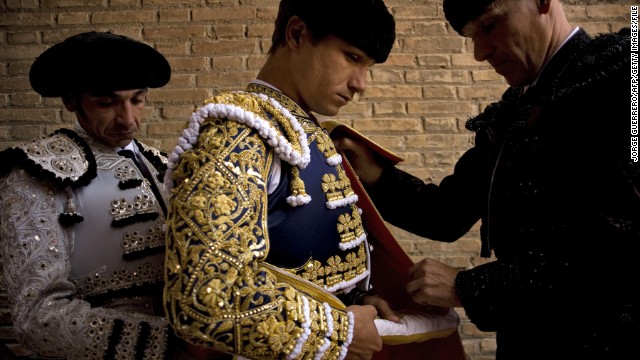 Spain has at least one common thread: bulls. In bars, aficionados might be glued to a televised bullfight and later scan a review of the fight in the arts, not sports, section of the newspaper. However, the popularity of the sport may be waning among the younger generation. Catalonia has banned it completely.
Spain has at least one common thread: bulls. In bars, aficionados might be glued to a televised bullfight and later scan a review of the fight in the arts, not sports, section of the newspaper. However, the popularity of the sport may be waning among the younger generation. Catalonia has banned it completely. 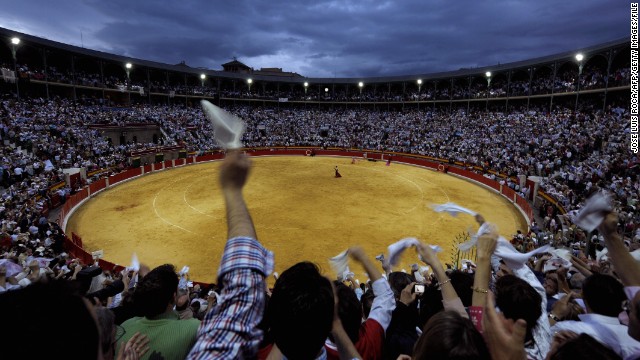 The bull is Spain’s iconic animal, and you won’t miss seeing at least one — alive, dead or fake. Bullfights such as this one in Granada still attract enthusiastic crowds.
The bull is Spain’s iconic animal, and you won’t miss seeing at least one — alive, dead or fake. Bullfights such as this one in Granada still attract enthusiastic crowds.  Spain is the world’s third-largest exporter of wine, fruits and vegetables.
Spain is the world’s third-largest exporter of wine, fruits and vegetables. 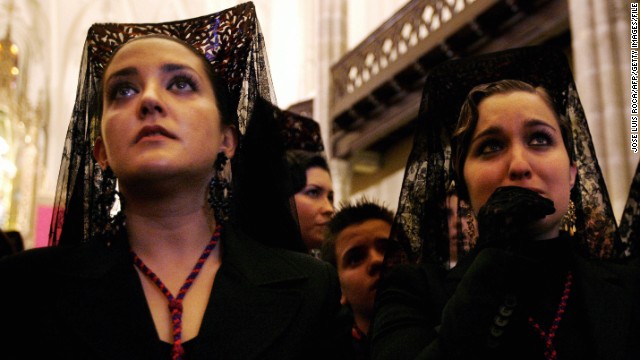 For many, religion remains a powerful part of everyday life in Spain. These women are dressed in traditional mantillas during Holy Week in Granada.
For many, religion remains a powerful part of everyday life in Spain. These women are dressed in traditional mantillas during Holy Week in Granada. 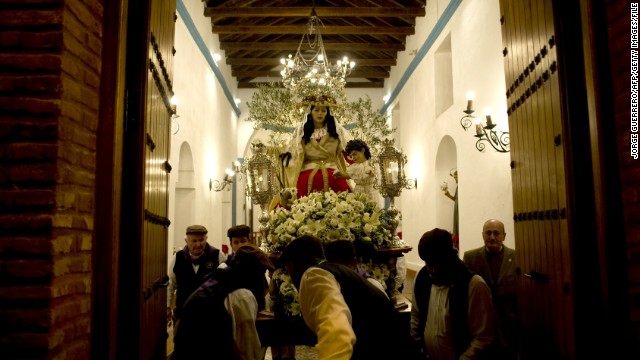 Music, food, drink, dance and dressing up make saints’ festivals a highlight of the year in Spain, even in the tiniest of villages. These revelers are taking part in la Fiesta de los Rondeles in Casarabonela.
Music, food, drink, dance and dressing up make saints’ festivals a highlight of the year in Spain, even in the tiniest of villages. These revelers are taking part in la Fiesta de los Rondeles in Casarabonela. 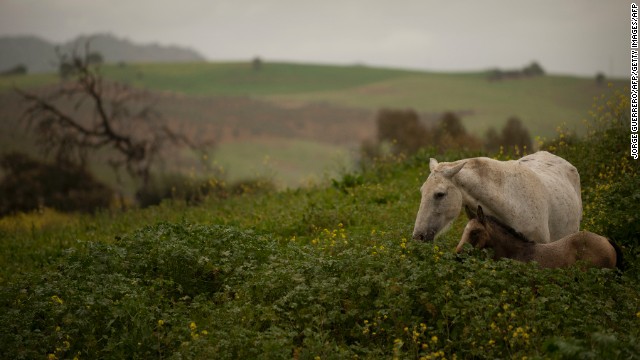 Spain is Western Europe’s second-largest country (after France) in terms of area.
Spain is Western Europe’s second-largest country (after France) in terms of area. 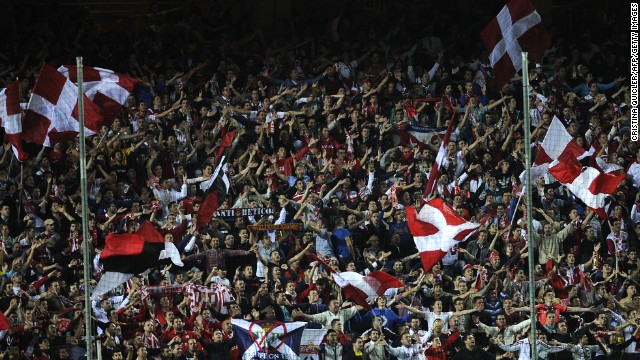 Spain is home to what many believe is the greatest club football team ever assembled — FC Barcelona. But other teams also have their fans. Here Sevilla FC supporters cheer their team during a match against Real Betis in Seville in November.
Spain is home to what many believe is the greatest club football team ever assembled — FC Barcelona. But other teams also have their fans. Here Sevilla FC supporters cheer their team during a match against Real Betis in Seville in November. 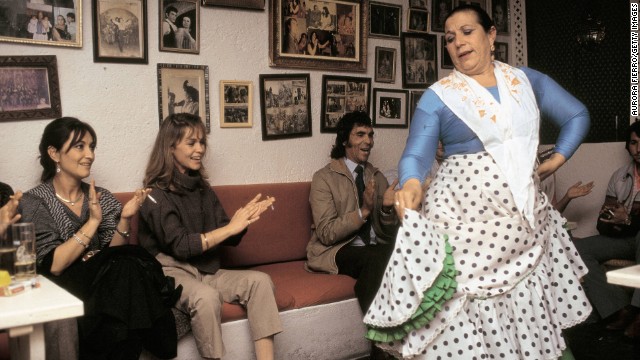 Flamenco shows remain popular. Here one takes place in a Granada neighborhood.
Flamenco shows remain popular. Here one takes place in a Granada neighborhood. 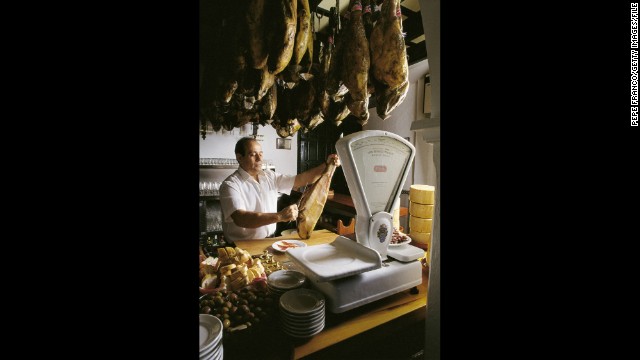 Jamón (cured ham) is a gastro-passion throughout Spain that inspires fierce rivalry between producers.
Jamón (cured ham) is a gastro-passion throughout Spain that inspires fierce rivalry between producers. 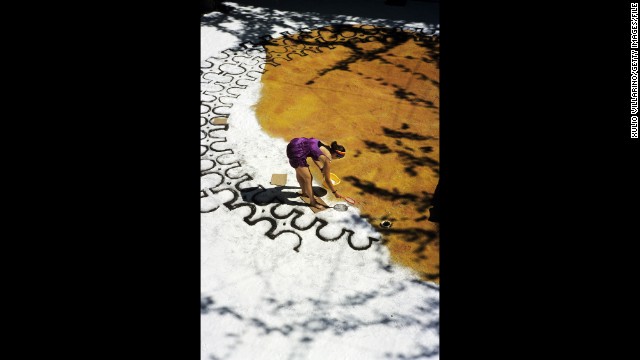 Spain is known for its tradition of cutting-edge art. Here, Jose Freixanes’ “Looking for Chantal” is made with mud, river sand and kolan.
Spain is known for its tradition of cutting-edge art. Here, Jose Freixanes’ “Looking for Chantal” is made with mud, river sand and kolan. 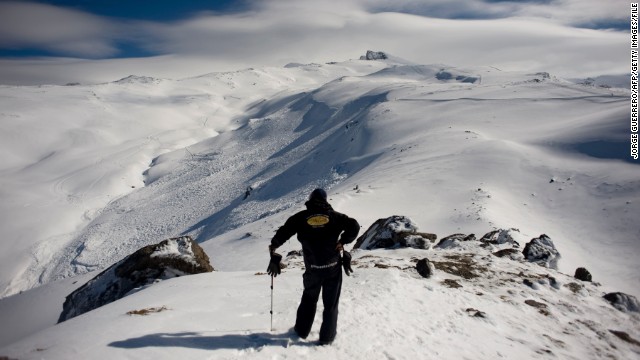 In winter, snows falls at higher elevations in Andalucia, sometimes bringing a surreal vision of olive groves blanketed in white. The peninsula’s highest mountain range, the Sierra Nevada, is almost permanently snow-capped.
In winter, snows falls at higher elevations in Andalucia, sometimes bringing a surreal vision of olive groves blanketed in white. The peninsula’s highest mountain range, the Sierra Nevada, is almost permanently snow-capped. 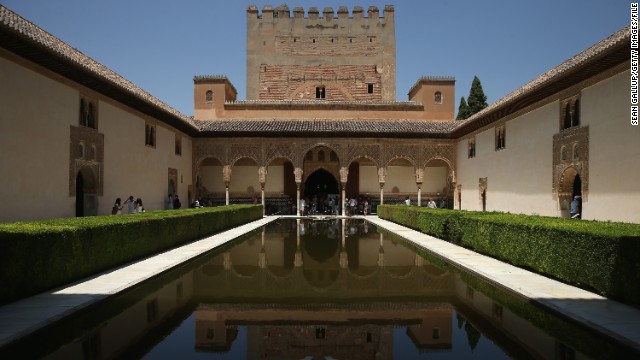 The reflecting pool in the Court of the Myrtles in the Nasrid Palaces at the Alhambra in Granada is a popular attraction.
The reflecting pool in the Court of the Myrtles in the Nasrid Palaces at the Alhambra in Granada is a popular attraction. 












No comments:
Post a Comment